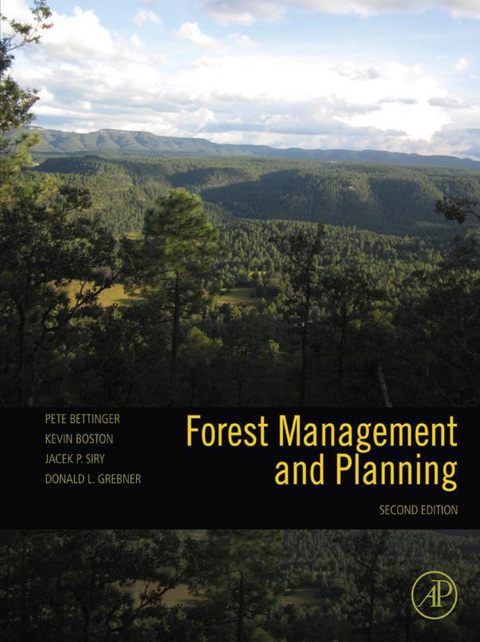Description
Efnisyfirlit
- Cover image
- Title page
- Table of Contents
- Copyright
- Dedication
- Preface
- Chapter 1. Management of Forests and Other Natural Resources
- Abstract
- I Introduction
- II Forest Management
- III The Need for Forest Management Plans
- IV General Emphasis of Forest Management Plans
- V Example Forest Plans
- VI Characterizing the Decision-Making Process
- VII Summary
- Questions
- References
- Chapter 2. Valuing and Characterizing Forest Conditions
- Abstract
- I Introduction
- II Structural Evaluation of Natural Resources
- III Economic Evaluation of Natural Resources
- IV Environmental and Social Evaluation of Natural Resources
- V Summary
- Questions
- References
- Chapter 3. Geographic Information and Land Classification in Support of Forest Planning
- Abstract
- I Introduction
- II Geographic Information Systems
- III Land Classification
- IV Summary
- Questions
- References
- Chapter 4. Estimation and Projection of Stand and Forest Conditions
- Abstract
- I Introduction
- II The Growth of Forests
- III Projecting Stand Conditions
- IV Output From Growth and Yield Models
- V Model Evaluation
- VI Summary
- Questions
- References
- Chapter 5. Optimization of Tree- and Stand-Level Objectives
- Abstract
- I Introduction
- II Tree-level Optimization
- III Stand-level Optimization
- IV Decision Tree Analysis
- V Mathematical Models for Optimizing Stand-level Management Regimes
- VI Dynamic Programming
- VII Summary
- Questions
- References
- Chapter 6. Graphical Solution Techniques for Two-Variable Linear Problems
- Abstract
- I Introduction
- II Example Problems in Natural Resource Management
- III Optimality, Feasibility, and Efficiency
- IV Summary
- Questions
- References
- Chapter 7. Linear Programming
- Abstract
- I Introduction
- II Four Assumptions Inherent in Standard Linear Programming Models
- III Objective Functions for Linear Programming Problems
- IV Accounting Rows for Linear Programming Problems
- V Constraints for Linear Programming Problems
- VI Detached Coefficient Matrix
- VII Model I, II, and III Linear Programming Problems
- VIII Interpretation of Results Generated from Linear Programming Problems
- IX Assessing Alternative Management Scenarios
- X Case Study: Western United States Forest
- XI Case Study: Northern United States Hardwood Forest
- XII Summary
- Questions
- References
- Chapter 8. Advanced Planning Techniques
- Abstract
- I Introduction
- II Extensions to Linear Programming
- III Binary Search
- IV Heuristic Methods
- V Forest Planning Software
- VI Summary
- Questions
- References
- Chapter 9. Forest and Natural Resource Sustainability
- Abstract
- I Introduction
- II Sustainability of Production
- III Sustainability of Multiple Uses
- IV Sustainability of Ecosystems and Social Values
- V Incorporating Measures of Sustainability Into Forest Plans
- VI Sustainability Beyond the Immediate Forest
- VII Summary
- Questions
- References
- Chapter 10. Models of Desired Forest Structure
- Abstract
- I Introduction
- II The Normal Forest
- III The Regulated Forest
- IV Irregular Forest Structures
- V Structures Guided by a Historical Range of Variability
- VI Structures Not Easily Classified
- VII Summary
- Questions
- References
- Chapter 11. Control Techniques for Commodity Production and Wildlife Objectives
- Abstract
- I Controlling the Area Scheduled
- II Controlling the Volume Scheduled
- III Application of Area and Volume Control to the Putnam Tract
- IV Area–Volume Check
- V Wildlife Habitat Control
- VI The Allowable Cut Effect
- VII Summary
- Questions
- References
- Chapter 12. Spatial Restrictions and Considerations in Forest Planning
- Abstract
- I Adjacency and Green-up Rules as They Relate to Clearcut Harvesting
- II Adjacency and Green-up of Group Selection Patch Harvests
- III Habitat Quality Considerations
- IV Road and Trail Maintenance and Construction
- V Summary
- Questions
- References
- Chapter 13. Hierarchical System for Planning and Scheduling Management Activities
- Abstract
- I Strategic Planning
- II Tactical Planning
- III Operational Planning
- IV Vertical Integration of Planning Processes
- V Blended, Combined, and Adaptive Approaches
- VI Your Involvement in Forest Planning Processes
- VII Summary
- Questions
- References
- Chapter 14. Forest Supply Chain Management
- Abstract
- I Introduction
- II Components of a Forestry Supply Chain
- III Association With the Hierarchy of Forest Planning
- IV Mathematical Formulations Associated With Forestry Supply Chain Components
- V Sources of Variation in the Forestry Supply Chain
- VI Summary
- Questions
- References
- Chapter 15. Forest Certification and Carbon Sequestration
- Abstract
- I Introduction
- II Forest Certification Programs
- III Cost and Benefits of Forest Certification
- IV Forest Carbon Sequestration
- V Opportunities and Challenges in Increasing Forest Carbon Storage
- VI Emissions Trading
- VII Selected US Carbon Reporting and Trading Schemes
- VIII Forest Carbon Implications for Forest Management
- IX Summary
- Questions
- References
- Chapter 16. Scenario Analysis in Support of Strategic Planning
- Abstract
- I Introduction
- II An Overview of the Role of Scenario Analysis
- III Developing Scenarios
- IV Applying Scenario Analysis to Forest Planning
- V Summary
- Questions
- References
- Appendix A. Databases Used Throughout Forest Management and Planning
- A.I A Douglas-Fir Stand From Western Oregon
- A.II The Lincoln Tract
- A.III The Putnam Tract
- Appendix B. The Simplex Method for Solving Linear Planning Problems
- B.I Introduction
- B.II Ten Steps That Represent the Simplex Method
- B.III A Two-Variable, Two-Constraint Problem Solved With the Simplex Method
- Questions
- Appendix C. Writing a Memorandum or Report
- C.I Memorandums
- C.II Reports
- Index






Reviews
There are no reviews yet.